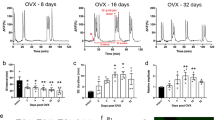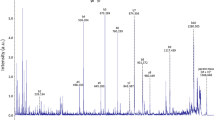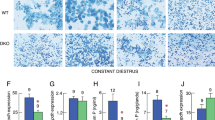Abstract
Neurons in the upper lumbar spinal cord project axons containing gastrin-releasing peptide (GRP) to innervate lower lumbar regions controlling erection and ejaculation. This system is vestigial in female rats and in males with genetic dysfunction of androgen receptors, but in male rats, pharmacological stimulation of spinal GRP receptors restores penile reflexes and ejaculation after castration. GRP offers new avenues for understanding potential therapeutic approaches to masculine reproductive dysfunction.
This is a preview of subscription content, access via your institution
Access options
Subscribe to this journal
Receive 12 print issues and online access
$209.00 per year
only $17.42 per issue
Buy this article
- Purchase on Springer Link
- Instant access to full article PDF
Prices may be subject to local taxes which are calculated during checkout



Similar content being viewed by others
References
Anastasi, A., Erspamer, V. & Bucci, M. Experientia 27, 166–167 (1971).
Battey, J. & Wada, E. Trends Neurosci. 14, 524–528 (1991).
Panula, P., Nieminen, O., Falkenberg, M. & Auvinen, S. Ann. NY Acad. Sci. 547, 54–69 (1988).
Sun, Y.G. & Chen, Z.F. Nature 448, 700–703 (2007).
Shinohara, K., Tominaga, K., Isobe, Y. & Inouye, S.T. J. Neurosci. 13, 793–800 (1993).
Ladenheim, E.E., Taylor, J.E., Coy, D.H., Moore, K.A. & Moran, T.H. Am. J. Physiol. 271, R180–R184 (1996).
Shumyatsky, G.P. et al. Cell 111, 905–918 (2002).
Roesler, R. et al. Eur. J. Neurosci. 19, 1041–1045 (2004).
Jensen, R.T., Battey, J.F., Spindel, E.R. & Benya, R.V. Pharmacol. Rev. 60, 1–42 (2007).
Truitt, W.A. & Coolen, L.M. Science 297, 1566–1569 (2002).
Carro-Juarez, M. & Rodriguez-Manzo, G. Brain Res. Brain Res. Rev. (in the press).
Meston, C.M. & Frohlich, P.F. Arch. Gen. Psychiatry 57, 1012–1030 (2000).
Morgan, C., Nadelhaft, I. & de Groat, W.C. J. Comp. Neurol. 201, 415–440 (1981).
Vizzard, M.A., Erdman, S.L. & de Groat, W.C. J. Neurosci. 15, 4033–4045 (1995).
Zoli, M. & Agnati, L.F. Prog. Neurobiol. 49, 363–380 (1996).
Acknowledgements
We thank A. Takara for technical assistance. Supported by Grants-in-Aid for Scientific Research from the Ministry of Education, Science, Sports, Culture and Technology, Japan (H.S., K.-I.M. and M.K.) and US National Institutes of Health grant NS28421 (S.M.B.).
Author information
Authors and Affiliations
Contributions
H.S., K.-I.M. and M.K. designed experiments and conducted data analysis. H.S. and H.H. performed histological experiments. H.S. and K.-I.M. performed molecular experiments. H.S. and D.G.Z. performed behavioral experiments. C.L.J., S.M.B., E.W. and K.W. provided Tfm rats, advice, antibodies and equipment. H.S., S.M.B. and M.K. wrote the paper. All authors discussed the results and commented on the manuscript.
Corresponding author
Supplementary information
Supplementary Text and Figures
Supplementary Figures 1–10, Supplementary Table 1 and Supplementary Methods (PDF 6567 kb)
Rights and permissions
About this article
Cite this article
Sakamoto, H., Matsuda, KI., Zuloaga, D. et al. Sexually dimorphic gastrin releasing peptide system in the spinal cord controls male reproductive functions. Nat Neurosci 11, 634–636 (2008). https://doi.org/10.1038/nn.2126
Received:
Accepted:
Published:
Issue Date:
DOI: https://doi.org/10.1038/nn.2126
This article is cited by
-
The gastrin-releasing peptide/bombesin system revisited by a reverse-evolutionary study considering Xenopus
Scientific Reports (2021)
-
A sexually dimorphic peptidergic system in the lower spinal cord controlling penile function in non-human primates
Spinal Cord (2018)
-
Spinal Mechanisms of Itch Transmission
Neuroscience Bulletin (2018)
-
Perinatal testosterone exposure is critical for the development of the male-specific sexually dimorphic gastrin-releasing peptide system in the lumbosacral spinal cord that mediates erection and ejaculation
Biology of Sex Differences (2016)
-
Rhythmic motor patterns accompanying ejaculation in spinal cord-transected male rats
International Journal of Impotence Research (2014)



